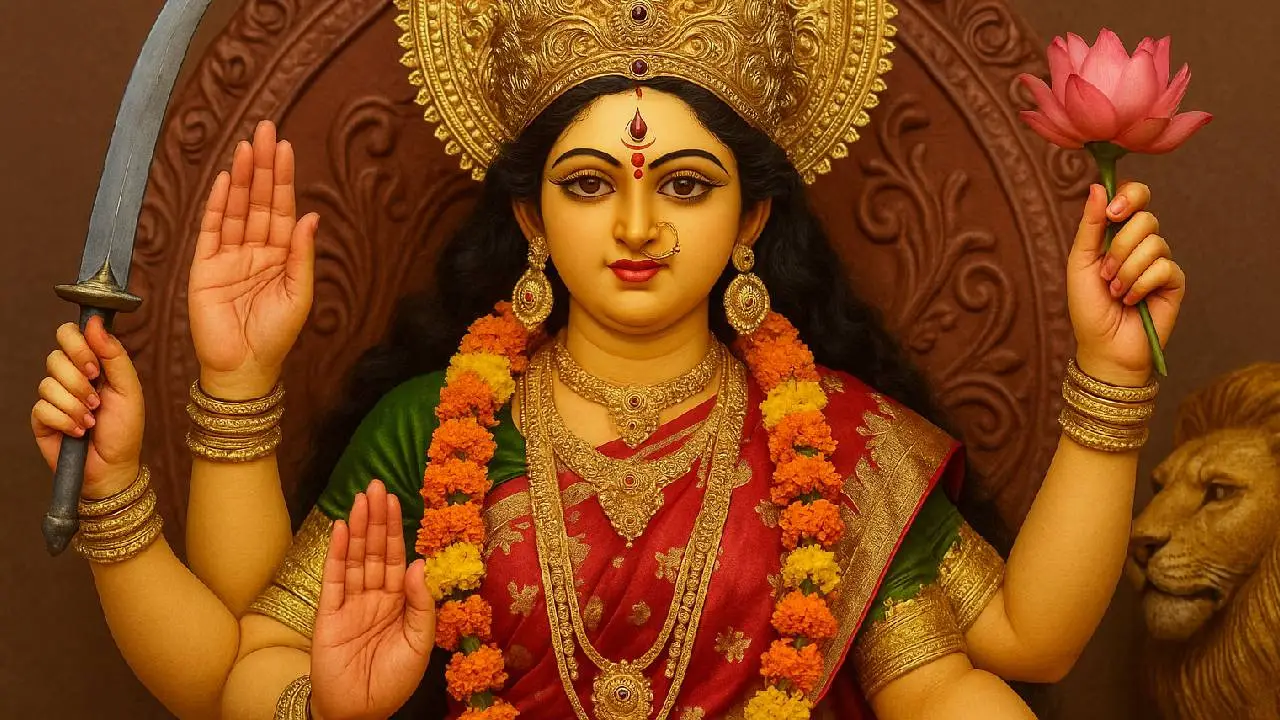
Credit: Ai (Credit: Ai)
Regional News: Navratri’s sixth day is dedicated to Maa Katyayani, known as the warrior goddess. She symbolizes power, courage, and victory over evil forces. Her golden aura shines like thousands of suns, representing divine strength. Worshippers believe she blesses them with fearlessness, prosperity, and wisdom. Devotees also pray to her for protection against negative influences. Stories from ancient texts describe her as the goddess who destroyed demons and restored peace. The day brings thousands of devotees together in temples across India.
The story of Maa Katyayani comes from sage Katyayan, a devoted follower of Goddess Parvati. He wished to have the goddess as his daughter and performed strict penance. Impressed by his devotion, Goddess Parvati fulfilled his wish and took birth as Katyayani. She later became a symbol of victory after killing demon king Mahishasura. This story is retold every Navratri, inspiring devotees with lessons of faith and courage. It also shows the bond between humans and divine blessings.
Maa Katyayani is often pictured riding a lion, holding a sword and a lotus in her four hands. Two of her hands show the Abhay Mudra, giving protection and blessings. She is considered the ruling goddess of Jupiter. People with weak Jupiter in their horoscope pray to her for relief. Her presence is said to remove obstacles in life. This belief adds deep astrological importance to her worship. Devotees believe her blessings change destiny itself.
On this day, devotees wake up early and take a holy bath. They light diyas, offer garlands, and present vermillion to Maa Katyayani. Seasonal fruits, homemade sweets, and meetha paan are offered as bhog. Many devotees chant Durga Saptashati or perform a special hawan. Those unable to complete long prayers chant Kavach Path instead. Reciting Maa Katyayani’s mantra 108 times is believed to attract good fortune. Evening aarti brings families and communities together in devotion.
One special belief is linked to unmarried girls. Ancient tales say the Gopis prayed to Maa Katyayani to marry Lord Krishna. Even today, unmarried girls perform puja on this day to seek their desired life partner. The mantra "Katyayani Mahamaye Mahayoginyadheeshwari, Nandgopsutam Devipatim Me Kurute Namah" is recited for blessings. Families encourage their daughters to pray sincerely. Many believe this ritual brings harmony and happiness into future marriages. This makes Day 6 especially popular among young women.
Grey is the color dedicated to Maa Katyayani. Devotees wear grey clothes and offer shringar items to the goddess. Special care is taken to prepare sattvik food for the day. After offering bhog to the goddess, devotees eat the prasad with family. Grey represents discipline, balance, and simplicity, matching the goddess’s teachings. Many also decorate temples and homes with grey flowers and fabrics. The color adds purity and symbolic strength to the puja.
While Navratri is celebrated everywhere, the grandeur is unmatched in West Bengal, Odisha, Bihar, and Tripura. Huge pandals are set up with artistic idols of Maa Katyayani. In cities like Kolkata, people gather in lakhs to witness Durga Puja. Devotional songs, dances, and rituals create a spiritual atmosphere. Families come together for prayers, cultural events, and sharing food. The spirit of devotion unites people of different backgrounds. The sixth day reflects the true power of India’s faith and culture.





Copyright © 2025 Top Indian News
